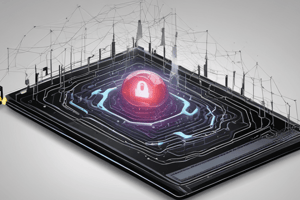Podcast
Questions and Answers
End-to-End Encryption ensures that only the ______ and intended recipient can access the encrypted data.
End-to-End Encryption ensures that only the ______ and intended recipient can access the encrypted data.
sender
End-to-End Encryption prevents ______ access, including internet service providers, governments, and hackers.
End-to-End Encryption prevents ______ access, including internet service providers, governments, and hackers.
third-party
The sender and recipient establish a shared ______ key without actually sharing it.
The sender and recipient establish a shared ______ key without actually sharing it.
secret
End-to-End Encryption ensures the message comes from the claimed ______.
End-to-End Encryption ensures the message comes from the claimed ______.
Symmetric Encryption uses the same key for ______ and decryption.
Symmetric Encryption uses the same key for ______ and decryption.
WhatsApp, Signal, and Telegram are examples of ______ messaging apps that use end-to-end encryption.
WhatsApp, Signal, and Telegram are examples of ______ messaging apps that use end-to-end encryption.
What is the primary objective of end-to-end encryption, and how does it achieve it?
What is the primary objective of end-to-end encryption, and how does it achieve it?
How does the key exchange process facilitate secure communication in end-to-end encryption?
How does the key exchange process facilitate secure communication in end-to-end encryption?
What is the role of encryption algorithms in end-to-end encryption, and why are they important?
What is the role of encryption algorithms in end-to-end encryption, and why are they important?
How does end-to-end encryption build trust between communicating parties, and what are the implications of this trust?
How does end-to-end encryption build trust between communicating parties, and what are the implications of this trust?
What are the benefits of using end-to-end encryption in messaging apps, and how do they impact user experience?
What are the benefits of using end-to-end encryption in messaging apps, and how do they impact user experience?
How does end-to-end encryption protect against man-in-the-middle attacks, and what are the consequences of such attacks?
How does end-to-end encryption protect against man-in-the-middle attacks, and what are the consequences of such attacks?
What is the significance of authenticity in end-to-end encryption, and how is it ensured?
What is the significance of authenticity in end-to-end encryption, and how is it ensured?
How does end-to-end encryption contribute to the integrity of the message, and what would happen if integrity were compromised?
How does end-to-end encryption contribute to the integrity of the message, and what would happen if integrity were compromised?
Flashcards are hidden until you start studying
Study Notes
What is End-to-End Encryption?
- A method of secure communication that ensures only the sender and intended recipient can read the messages
- Prevents third-party access, including internet service providers, governments, and hackers
How End-to-End Encryption Works
- Key Exchange: sender and recipient establish a shared secret key without actually sharing it
- Encryption: sender encrypts the message using the shared key
- Transmission: encrypted message is transmitted over the internet
- Decryption: recipient decrypts the message using the shared key
Key Features of End-to-End Encryption
Confidentiality
- Ensures only the sender and recipient can access the encrypted data
Authenticity
- Ensures the message comes from the claimed sender
Integrity
- Prevents tampering or modification of the message during transmission
Types of End-to-End Encryption
Symmetric Encryption
- Uses the same key for encryption and decryption (e.g., AES)
Asymmetric Encryption
- Uses a pair of keys: one for encryption and another for decryption (e.g., RSA)
Examples of End-to-End Encryption
- Secure Messaging Apps: WhatsApp, Signal, and Telegram use end-to-end encryption to protect user communications
- Email Encryption: some email services, like ProtonMail, offer end-to-end encryption for email communications
- Virtual Private Networks (VPNs): some VPNs use end-to-end encryption to protect user data transmitted over the internet
What is End-to-End Encryption?
- End-to-end encryption is a method of secure communication where only the communicating users can read the messages.
- It ensures that only the sender and intended recipient can access the encrypted data.
How it Works
- The sender and recipient establish a shared secret key using a secure key exchange protocol, like Diffie-Hellman or RSA.
- The sender encrypts the message using the shared secret key and an encryption algorithm, like AES.
- The encrypted message is transmitted over an insecure channel, like the internet.
- The recipient decrypts the message using the shared secret key and the same encryption algorithm.
Characteristics
Confidentiality, Authenticity, and Integrity
- Confidentiality: Only the sender and intended recipient can access the encrypted data.
- Authenticity: The sender and recipient can verify the authenticity of the message.
- Integrity: The message remains intact and unchanged during transmission.
Benefits
- Privacy: Sensitive information remains private and confidential.
- Security: Protects against eavesdropping, tampering, and man-in-the-middle attacks.
- Trust: Builds trust between the communicating parties, as they can be certain that only they can access the encrypted data.
Examples of End-to-End Encryption
- WhatsApp: Uses the Signal Protocol for end-to-end encryption of messages, voice and video calls.
- Signal: A messaging app that provides end-to-end encryption for messages, voice and video calls.
- ProtonMail: A secure email service that uses end-to-end encryption for email communication.
Studying That Suits You
Use AI to generate personalized quizzes and flashcards to suit your learning preferences.




